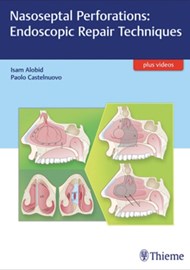This 181-page book, published in 2017, comes with 218 illustrations and online videos of the described techniques. The authors take us through a detailed description of the anatomy and physiology of nose and then discuss the various causes of nasal septal perforations. After this, the conservative management of symptomatic nasal septal perforation is explained. The rest of the book is on various endoscopic surgical closure techniques. All descriptions are helped with photos, scans and diagrams.
An honest assessment has been made about the use of buttons to cover nasal septal perforations. The authors consider surgical closure of the nasal septal perforations as the best option and keep buttons for surgically unsuitable situations. The possible disadvantages of buttons such as bleeding, rusting, pain and erosions of the edge of the perforations are also highlighted.
A large number of surgical techniques are described. This varies from free flaps to pedicled pericranial flaps for almost total nasal septal perforations. The size of perforation suitable for each flap is given in the beginning with helpful tips and tricks at the end. My favourites are the lateral nasal flaps and advancement flaps with interposition grafts.
Even though the tile is endoscopic repair, all these can be used through an open approach. The chapter on bilateral septal mucosal flaps shows photos of open rhinoplasty approach.
This book is a must-read for any surgeon interested in surgical closure of nasal septal perforations and I have no hesitation to rank it 4 out of 5.




